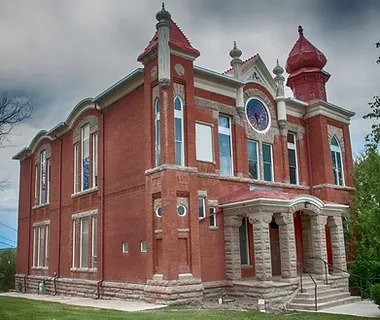It was a typical early Spring Day in Trinidad, bright sun, blue skies and a brisk but not particularly bitter wind. It was the kind of breeze that either folded arms or light jacket could suffice for blunting the chill. But on March 23rd, it would have taken a whole lot more than a little wind to keep the crowd away from Temple Aaron, a landmark structure that has graced the long-ago coal mining town for the last 135 years.

Temple Aaron, the landmark red brick building that has stood sentry at the corner of 3rd and Maple, was recently added to the National Historic Registry. The town’s Jewish community, one that may only number a dozen or so, along with Jews from up and down I-25, including a cadre from Albuquerque to the south and as far away as Fort Collins to the north, were there to mark the moment.
Aaron, for whom the synagogue is named, is an important figure in the Jewish Bible. He was said to be the founder of the Israelite priesthood and elder brother of Moses. He is also said to have been a driving force in leading the Israelites out of slavery and through the forty-year trek across the desert.
But today, an ancient Aaron has connected or reconnected a 21st century gathering of Jews in a town that many may have never even suspected had a Jewish lineage.
“I had never considered Jews in Trinidad. I knew nothing…that there was even a synagogue there,” said Denver commercial realtor Neal Paul. But there is one; a simple building, constructed with old red brick and adorned on the inside with meticulous craftsmanship, complemented by stained glass windows that create a comforting light that rests lightly on worshippers.
And though Paul, like so many others, only learned of the synagogue and its potential sale and possible razing just a few short years ago, he has since learned a lot. And almost everything has surprised.
Despite scant history of Trinidad’s Jewish community, Paul said, Jews have always been part of the town’s fabric. “The Jews that settled in Trinidad,” he said, “mostly came from the Eastern United States,” and many among them were German immigrants. The railroad, which served pas- sengers and carried heavy loads of everything from coal to construction materials, also had it as a regular stop.
The Jews who came to the town were a mix of the merchant class while others, like so many immigrants who worked the mines of southern Colorado, were laborers.
Some, said Paul, were also Latino, descended from the Jews who were among the early arrivals from Spain and Portugal. “Some considered themselves crypto-Jews,” he said. Crypto-Jews were those who held their religion in secret while professing to be Christians. “Many were forced to give up their Jewish faith,” he said. “Their choice was life, living. They chose to stay alive but keep their faith.” While their presence has been recorded, their actual numbers remain a mystery.
Because of distance, Paul, like so many Jews who attended the March event, does not attend Temple Aaron services. But on its rolls, Paul said, there are approximately
“90 paid members and 2,000 who are on our distribution list.” The group represent Jews who are spread across the country. But just like him, Paul said, they all consider themselves a part of the historic place of worship. A recent Colorado Public Radio story also said that a monthly Torah study is streamed via Zoom.
The Denver realtor said his first visit to Trinidad to see Temple Aaron with his own eyes was a special moment.
“When you walk inside and see it, in a way, it’s spectacular; not the Taj Mahal, not the White House, but a special little representation of a lot of energy and dedication to a group of people who came before us.” The historic designation, Paul said, provides a “sense that it now belongs to future generations.”
The fact that Temple Aaron came so close to a closing chapter in Trinidad’s history still causes a moment for pause for Paul, whose parents, he said, both survived Auschwitz. Many who joined him for the official dedication shared the same family legacy of Hitler’s ‘Final Solution.’
Despite Trinidad’s population—the 2020 U.S. Census counted its population at just over 9,000—the town may be on a slow but demonstrable upswing. Because of Colorado’s relaxed marijuana laws and a growing presence of energy companies drilling for natural gas where fallow coal mines still stand, new economic blood is being infused in the region.
While Easter is a Christian remembrance and not a Jewish one, last Sunday was a typically quiet day at Temple Aaron. But Passover, the story of the Exodus and the one of the most important Jewish observances, will be marked on April 20th.
But for people like Paul, the designation on the federal landmark registry for Temple Aaron now means that Trinidad’s past has now been catapulted to a whole new century. The plaque now adorning the edifice of the 135-year-old synagogue also tells a simple but important story of resilience. The plaque reads that Jews, like so many other new Americans, were indeed part of the westward migration into the America’s Southwest. And that they also played “a vital role in the civic, economic and religious life of the community.”



